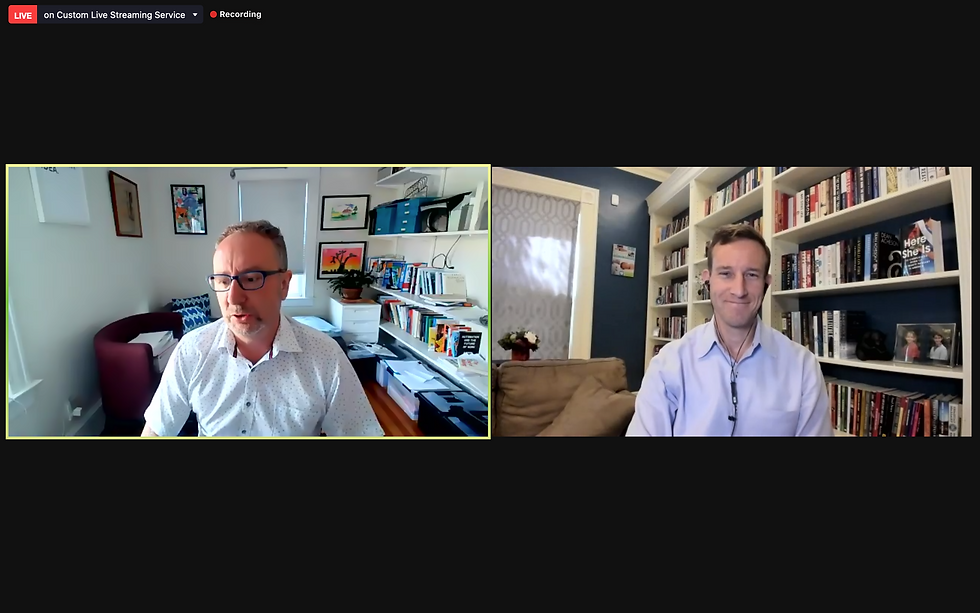BIDENOMICS AND BEYOND - A WEBINAR BY BROWN UNIVERSITY
- vama.maniar

- Jun 7, 2021
- 3 min read
MY TOP 10 TAKEAWAYS
On June 02, 2021, I attended a webinar held by Brown University on Bidenomics. This was a conversation between Mark Blyth and John Friedman where both of them shared their thoughts and opinions on this subject.

1. Bidenomics is a new way of thinking about the economy that is augmented through different levels of economic spending based on President Biden’s principles.
2. It proposes an increased spending on physical infrastructure which in turn leads to productivity and a higher employment rate increasing the country's GDP.
3. It has been seen that the top income earners have tripled their income since the time the recession ended whereas the lower earners income has only risen by 15%. Now, via Bidenomics, the government wants to focus on creating a more balanced growth.
4. There has been a transition from manufacturing sectors to higher profitability sectors, which require improved levels of skill, giving more job opportunities to those with a higher generalized education and higher skill set in technology so people with higher skill sets or are able to train themselves to be more technologically oriented are able to be a part of the high earning groups. For example, a higher demand for healthcare during the pandemic has increased the earnings of doctors whereas manufacturing factories have been forced to remain shut since the past 15 months, leading to low or no income for workers in the sector.
5. Bidenomics’ aim is to improve education and make it more widely available so that everyone has access to jobs in higher profitability sectors. In 1980, the number of college graduates increased more than the number of job opportunities available. Employees with educational degrees were paid more than those without a degree. For too long, many valuable human resources have been left unutilized and due to lack of access to education, there have been many barriers for these resources to gain access to these opportunities.
6. We need to differentiate between inflationary worries in the long term from short-term inflationary spikes. For example, once lockdown is over, people will have taken all vaccination doses, with pent-up demand being unleashed, and savings from government support being spent, prices are bound to spike. However, this will pass in 6 to 9 months and prices will normalize. Such short term inflationary spike should not be confused with long term worrisome inflation.
7. The economy has been recovering so quickly that it’s almost seen to be a V shaped recovery. However, this is for higher income earners only. Low wage earners have had a deep fall. For them, there was a fast recovery last summer, but it has been flat lined in the last 10 months. Even though businesses have started hiring, many lost low wage jobs aren’t coming back. For example, workers from the Manhattan Chipotle have been laid off since the past 12 months whereas the other smaller Chipotle branches on the outskirts have already brought employees back to work.
8. The FED has shifted focus from inflation to balancing inflation vis a vis unemployment. People are realizing that a higher inflation rate of 3%, due to low interest rates, is manageable as they have confidence in the economy.
9. The stigma around debt has reduced. Earlier debt was directly correlated to bankruptcy. People are now opening their eyes to a concept called ‘sustainable debt’. Debt has been misconceived by the common man to believe that everything will be taken away overnight if they are in debt. Obviously, no one wants to get to that point. Lately it has been seen that people are more accepting of debt levels that they can manage to pay from their wages.
10. During covid, enormous fiscal spending has been evidenced, mainly with a focus on the unemployment coverage, and is expected to end in August- September 2021 timeframe. Currently it doesn’t seem likely that the ending of fiscal spending will result in a fiscal Cliff. However, there is some worry that a fiscal cliff may occur if the Republicans win both houses in November 2022.
After this insightful webinar, not only was I able to comprehend and relate topics taught in school better but I also gained a new approach to thinking about the economy. I hope my top 10 takeaways, in turn, help you take something away as well.
VAMA MANIAR
Mark Blyth: http://markblyth.com
John N. Friedman: https://sites.google.com/brown.edu/johnnfriedman/home
Webinar: https://watson.brown.edu/events/2021/bidenomics-and-beyond-conversation-mark-blyth-and-john-friedman




Wow this was very well put together. An apt breif of the entire webinar 🤌🏼🥳🤞
Excellent synopsis. Modern capitalism is focused on exponential growth and productivity. Savings and savers in the current zero / negative interest environment are not rewarded. Thus I hope that there is a more balanced approach in terms of supply, demand and growth.
Really fascinating summary of the talk about Bidenomics, which has been a paradigm shift in economic policy to rebuild and restructure the supply-side of the American economy. I liked how you talked about the disparity in effects of the economic recovery between high and low wage earners. It was a really comprehensive summary of the current and future state of the economy and the different challenges that need to be mitigated.
Really precise and informative, loved it!!
Great writeup and